During 1947 a production batch of six was laid down, for which the registrations G-AKBF to G-AKBK were reserved. G-AKBF was earmarked for the Nawab of Bhopal (the Muslim ruler of the state Bhopal within British India) and the registration VT-COT was reserved in India. Two others were ordered by British European Airways (BEA), one for radio research and one for general development flying. However, in November 1947, as part of a heavy retrenchment program on the part of BEA, the contract for these two aircraft was cancelled. On the receipt of this cancellation Cunliffe-Owen announced that it would immediately abandon aircraft manufacture."
Type: Ten/twelve-seat feeder-line monoplane.
Wings: Cantilever low-wing monoplane. Single-spar structure in three main sections consisting of center sectionand two detachable outer wings. Detachable tips. Main spar at 30% chord had extruded light alloy T-section booms riveted to stiffened plate web, and was continuous through fuselage. Built-up false spar was pinned to fuselage bulkhead. and closes torsion-box formed by main spar and top and bottom skins. Braced channel-section ribs attached forward and aft of spar, and spanwise stringers. Stressed metal skin of varying thickness riveted on. All-metal ailerons with trim-tab in each, and electrically-operated slotted trailing edge flaps carried on false spar.
Fuselage: All-metal monocoque structure. Built-up light alloy transverse frames, bulb-section extruded light alloy longitudinal stringers and stressed metal skin. Structural bulkheads between pilot's compartment and main cabin, at main and false-spar attachments and at tail pick-up points.
Tail unit: Cantilever monoplane type. All-metal structure with horn-balanced and aerodynamically-balanced rudder and elevators, trim tabs in each.
Landing gear: Retractable tricycle type. Main wheels carried on shock-absorber legs retract forward into engine nacelles between fire-proof bulkhead and main spar and were enclosed by doors. Full-castering self-centering nose wheel attached to heavy keel members under fuselage retracted rearwards and turned through 90° so as to lie flat within fuselage. Electric operation with emergency manual lowering gear.
Power plant: Two 500 hp Alvis Leonides LE4M nine-cylinder air-cooled radial engines enclosed in long-chord cowlings with leading edge exhaust collector rings and controllable trailing edge gills. de Havilland or Rotol three-blade constant-speed full-feathering and braking airscrews, with electro-hydraulic control. Four flexible crash-proof fuel-tanks in wing leading edge.
Accommodation: Crew compartment forward separated from main cabin by bulkhead. Main sound-proofed cabin has accommodation for up to twelve passengers, six on each side of central aisle. Entry door on port side aft of wing. Windows had double layer of safety-glass with sealed anti-misting space between, and were built into removable breakout panels to act as emergency exits. Toilet and luggage compartments at rear. Over-seat racks in cabin for personal luggage.
In the following data, weights and loadings are design numbers, while the performance shows estimated numbers.
Span: 57 ft 0 in (17.38 m)
Length: 44 ft 2 in (13.45 m)
Height: 16 ft 8 in (5.12 m)
Wing area: 435 sq.ft (40.5 sq.m)
Wing chord, at root (on fuselage center line): 11 ft 8.4 in (3.57 m)
Wing chord, at tip (at outer end of aileron): 4 ft 8.15 in (1.42 m)
Wing center sectionspan: 20 ft 0 in (6.1 m)
Wing incidence: 3°
Wing aspect ratio: 7.46
Wing dihedral (on median line): 6.5°
Tail plane span: 20 ft 0 in (6.1 m)
Wheel track: 15 ft 6 in (4.72 m)
Wheel base: 15 ft 0 in (4.57 m)
Main wheel tire pressure: 40 lb/sq.in (2.8 kg/sq.cm)
Nose wheel tire pressure: 45 lb/sq.in (3.16 kg/sq.cm)
Propeller diameter: 9 ft 0 in (2.74 m)
Propeller ground clearance: 12 in (30.5 cm)
Distance between propeller centers: 15 ft 6 in (4.72 m)
Entry door: 4 ft 4 in by 2 ft 3 in (1.32 m by 0.68 m)
Luggage capacity: 45 cu.ft (1.27 cu.m)
Empty weight: 7,031 lb (3,189 kg)
Loaded weight: 11,000 lb (4,989 kg)
Wing loading: 25.3 lb/sq.ft (123.47 kg/sq.m)
Power loading: 11 lb/hp (4.98 kg/hp)
Fuel capacity: 240 gal (909 l)
Max speed: 223 mph (359 kmh) at 3,255 ft (990 m)
Cruise speed: 190 mph (306 kmh) at 7,000 ft (2,135 m)
Stall speed: 70 mph (113 kmh)
Max climb: 1,420 ft (433 m)/min
Take off run: 948 ft (289 m)
Service ceiling: 21,000 ft (6,400 m)
Range: 1,200 mls (1,930 km)
